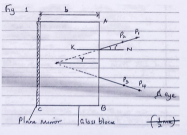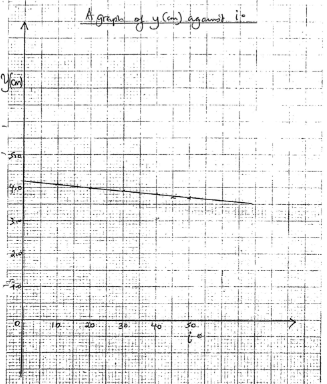INSTRUCTIONS TO CANDIDATES:
- Write your Name and Index Number in the spaces provided above.
- Sign and write the date of examination in the spaces provided above.
- Candidates are advised to record their observations as from as they are made.
- Non-programmable silent electronic calculators may be used.
QUESTION 1
You are provided with the following apparatus.
- Rectangular glass block
- Four optical pins
- Metre rule
- Protractor
- Soft board
- White plain paper
- Cellotape
- 4 thumb tacks
- Plane mirror
Proceed as follows:-
-
- Measure and record the breadth b of the glass block b = cm (1mk)
- Using cellotape, fix the mirror on one side (length) of the glass block and trace the outline on the plain paper.
- Draw the normal NK to the side AB and measure angle i = 10° from the normal.
- Draw the line representing the incident ray and fix pins P1 and P2 as shown in figure 1.
- By observing the images of the pins P1 and P2 locate the positions P3 and P4 such that they appear in a line (no-parallax) using other pins.
- Join the points P3 and P4 and extend them to intersect line P1 P2 produced. Measure the perpendicular distance Y.

- Repeat the steps for different values of i and record your results in the table below.
Table 1
(5mks)i (º) 10 20 30 40 45 y (cm) - Plot a graph of y against i
(5mks) - Given that kyo = b where yo is the y-intercept determine the value of k
(2mks) - What is the significance of k
(1mk)
- Now remove the mirror, place the rectangular glass block on the plain paper and draw its outline again.
- Remove the block and draw a perpendicular line NX on one of the longer sides as shown in figure 2

- Draw an incident ray at angle of 30° to NX
- Fix pins P1and P2 along the line for the incident ray then replace the block in its position.
- By viewing through side AD, fix P3 and P4 in line with images of P1 and P2.
- Remove the block and draw the line P3P4 to touch AD of the block. Join Y to X and measure the angle of refraction r.
- Record your results and complete the table
Table 2
(3mks)i (º) r (º) Sin i Sin r 30 - Determine the value of t given that
Sin r = 1
2t
NOTE: Submit the white plain paper
- Remove the block and draw a perpendicular line NX on one of the longer sides as shown in figure 2
QUESTION 2
SECTION A
You are provided with the following
- A watch glass
- A small piece of plasticine
- Marble
- Stop watch
- Vernier calipers (To be shared)
- An electronic balance (To be shared)
Proceed as follows:-
- Measure and record the mass of the marble m = g
(2mks) - Place the watch glass flat on the table with a small piece of plasticine to fix it firmly on the bench at the one place it touches.
(1mk) - Release the marble from one end of the watch glass and time 5 complete oscillations with a stop watch
(1mk) - Repeat this three times

- Fill the table below
(3mks)Time for 5 ocillations Periodic Time (s) 1 2 3 - Find the average periodic time T(s)
(1mk) - Measure the diameter of the Marble with Vernier Calipers and hence find its radius.
Diameter d cm
(1mk)
Radius r cm
(1mk) - Determine the volume of the Marble given that
V = 4/3 π r 3 where π = 3.142
r = radius in metres
(2mks) - Calculate the inner radius of curvature of the watch glass R from the formular (2mks)
R - r = gT2
4 π 2
where g = 10N/kg
π = 3.142 and
R is in metres. - Determine the density of the marble in SI units.
SECTION B
You are provided with the following:-
- Voltmeter (0-5v)
- 100cm bare nichrome wire fixed on a mm scale
- Micrometer screw gauge
- Two size D dry cells in a holder
- Connecting wires
Proceed as follows:-- Using a micrometer screwgauge, measure the Diameter of the nichrome wire.
D = mm
(1mrk) - Determine the cross sectional area A given that
A = 11D2 where D is in metres
14
(2mks) - Set up the apparatus as shown below

- Measure the emf E of the cells where the jockey is not connected to Q
- Connect the Jockey to Q (Length L = 100m) and record the value of V
V = V
(1mk) - Given that 1/v = rA/fLe + 1/E where r is the internal resistance of and f is the resistivity of the nichrome wire, determine the value of r if f = 1.0 x 10-6 Ωm
(2mks)
- Using a micrometer screwgauge, measure the Diameter of the nichrome wire.
MARKING SCHEME
QUESTION 1
-
- b = 6.3 ± 0.2cm 1d.p
(1mk) - Diagram
(1/2mk ) -
1 mark eachiº 10 20 30 40 50 Y (cm) 4.1 4.0 3.9 3.8 3.7
(5mks) - Graph
S-1
P-2
L-1
A-1
5
(5mks) - Ky0 = b
K = b
y0
K = 6.3
4.2
K = 1.5 (1.4 - 1.6)
Answer
No Units
(1mk) - K is the refractive index of glass.
(1mk)
- b = 6.3 ± 0.2cm 1d.p
- Diagram
(1⁄2 mk) -
iº Rº Sin i Sin r 30 18-21 0.5000 0.3256
No d.p 4s.f or exact
1mk each
(3mks)
- Sin r = 1
2t
0.3256 = 1
2t
Rt = 1
0.3256
2t = 3.071
t = 3.071
2
t = 1.536
Substitution (1mk)
4s.f (1mk) or exact No units
(2mk)
QUESTION 2
SECTION A.
- M = 5.0g ± 1.0 (1mk) 1 or 2 dip
(1mk) -
Use student's value correct evaluationTime for S oscillations Periodic time T(s) 1 4.02 0.8040 2 4.04 0.8080 3 4.00 0.8000
2mk (2d.p) 4s.f or exact (1mk)
(3mks)
any two correct - Average T = 0.8040 +0.8080 +0.8000 (1⁄2 mk)
3
= 0.804 sec (1⁄2 mk) current units
4s.f or Exact - Diameter = 1.60 ± 0.01cm (1mk) 2d.p
Radius = 0.8 (1mk)
correct evaluation
Use candidates, answer 4s.f - V = 4/3 π r3
4/3 x 3.142 x 0.0083 1mk
V = 6.435 x 10-6 m3 (1mk)
evaluation
(2mks) - R - r= gT2
4Π2
R-r=0.1637
R-0.8 = 0.1637 + 08
R = 0.9637m - (1mk) Use students' correct evaluation
4s.f or exact
Units a must. - Density = mass
volume
= 5.0 x 10-3 correct substitution using students values
6.435x10-6 correct evaluation Units a must
= 777 kg/m3
SECTION B
- D = 0.36 ± 0.01mm 2d.p
(1mk) - A = 11D 2
14
A = 11 x (3.6 x10-4)-2 (1mk) substitution
14
A = 1.018 x 10-7 m2 (1mk) correct Evaluation
units a must - E = 3.1 ± 0.1 V (1mk) 1 d.p
- V (2.0 - 2.8) V (1mk) 1 d.p
- 1 = rA + 1
v fLe E
1/2 = 1.018 x 10-7xr + 1 (1mk) correct
1.0 x 10-6 x 1 x 3.0 3.0
1/2 = (0.0339)r + 0.3333 substitution
0.339r = 0.167 4s.f or exact
R = 4.926Ω (1mk) unit is a must
Use student's evaluation
Download Physics Paper 3 Questions and Answers - Catholic Diocese of Kakamega Mock Exams 2023.
Tap Here to Download for 50/-
Get on WhatsApp for 50/-
Why download?
- ✔ To read offline at any time.
- ✔ To Print at your convenience
- ✔ Share Easily with Friends / Students
